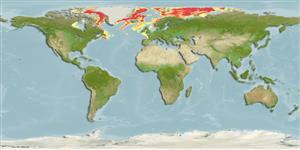Common names from other countries
Environment: milieu / climate zone / depth range / distribution range
Écologie
; profondeur 100 - 1739 m (Ref. 119523). Polar; 81°N - 44°N, 95°W - 141°E
Distribution
Pays | Zones FAO | Écosystèmes | Occurrences | Introductions
North Atlantic and the Arctic: from Eastern Canadian Arctic east to Laptev Sea, north to Svalbard and the Arctic and south to Newfoundland and Labrador, Canada. Temperate to polar.
Length at first maturity / Taille / Poids / Âge
Maturity: Lm ? range ? - ? cm
Common in canyons (Ref. 119581).
Life cycle and mating behavior
Maturité | Reproduction | Frai | Œufs | Fécondité | Larves
Members of the class Anthozoa are either gonochoric or hermaphroditic. Mature gametes are shed into the coelenteron and spawned through the mouth. Life cycle: The zygote develops into a planktonic planula larva. Metamorphosis begins with early morphogenesis of tentacles, septa and pharynx before larval settlement on the aboral end.
Piepenburg, D., N.V. Chernova, C.F. von Dorrien, J. Gutt, A.V. Neyelov, E. Rachor, L. Saldanha and M.K. Schmid. 1996. (Ref. 2952)
Statut dans la liste rouge de l'IUCN (Ref. 130435)
statut CITES (Ref. 108899)
Not Evaluated
Not Evaluated
Utilisations par l'homme
| FishSource |
Outils
Plus d'informations
Taille/Âge
Croissance
Longueur-poids
Longueur-longueur
Morphologie
Larves
Abondance
Sources Internet
Estimates based on models
Catégorie de prix
Unknown.
